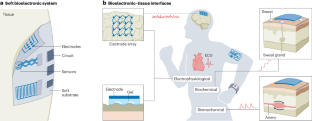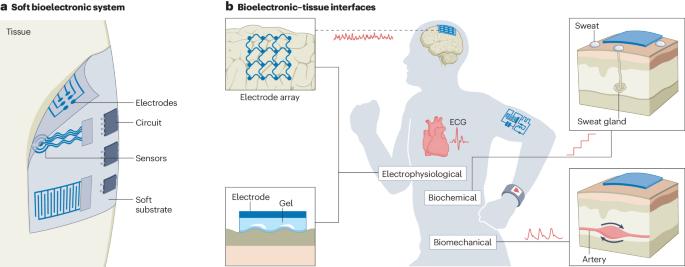Motion artefact management for soft bioelectronics
引用次数: 0
Abstract
Soft bioelectronic devices can be interfaced with anatomically curved organs, such as the heart, brain and skin, to provide continuous analysis of physiological information. However, body movements and physiological activities may induce motion artefacts, which can adversely affect signal accuracy and stability. Importantly, motion artefact management is key to promoting the clinical translation of soft bioelectronics to ensure that soft bioelectronic devices can selectively detect target biological signals with high accuracy. In this Review, we discuss how body activities can affect the soft bioelectronic–tissue interface and result in motion artefact signals, including interface impedance instability motion artefacts, biopotential motion artefacts and mechanical motion artefacts. We then investigate different motion artefact management strategies, including materials engineering, device and circuit design, and algorithmic intervention, to reduce the contribution of motion artefacts to signal acquisition, processing and interpretation. Motion artefacts challenge the translational application of soft bioelectronics by distorting physiological monitoring. This Review introduces fundamental causes of motion artefacts and discusses various management strategies, including materials usage, bioelectronics design and algorithmic intervention.


软生物电子学的运动伪影管理
软生物电子设备可与心脏、大脑和皮肤等解剖学上弯曲的器官连接,提供连续的生理信息分析。然而,身体运动和生理活动可能会产生运动伪影,从而对信号的准确性和稳定性产生不利影响。重要的是,运动伪影管理是促进软生物电子技术临床转化的关键,以确保软生物电子设备能选择性地高精度检测目标生物信号。在本综述中,我们将讨论人体活动如何影响软生物电子-组织界面并导致运动伪影信号,包括界面阻抗不稳定运动伪影、生物电位运动伪影和机械运动伪影。然后,我们研究不同的运动伪影管理策略,包括材料工程、设备和电路设计以及算法干预,以减少运动伪影对信号采集、处理和解读的影响。
本文章由计算机程序翻译,如有差异,请以英文原文为准。
求助全文
约1分钟内获得全文
求助全文

 求助内容:
求助内容: 应助结果提醒方式:
应助结果提醒方式:


